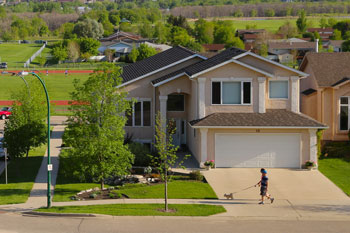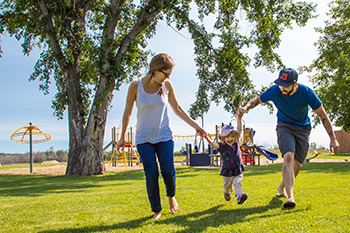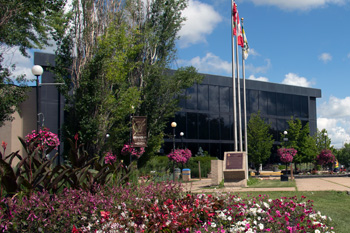A: The 2025 Ambulance Rates can be found here.
Q. How do I apply for a Fire Permit?
A: The various Fire Permit applications and information can be found here.
Q. I just bought a fire extinguisher 3A10BC and would it be possible to explain to me what the numbers mean: 3A10BC?
A: Fire extinguishers are tested and rated by the Underwriters Laboratories of Canada (ULC in Canada and UL in the USA) for the class and size of fire that they will extinguish.
Class "A" fire extinguishers are to be used on ordinary combustibles such as wood, paper, cloth, rubber, straw, etc. An example would be a 2.5 U.S. gallon pressurized water extinguisher which has a 2-A rating.
The number is used to identify the amount of fire extinguishing potential of the different types of extinguisher suitable for use on Class "A" fires. For example, a 4-A extinguisher can be expected to extinguish approximately twice as much fire as a 2-A extinguisher.
Class "B" fire extinguishers are used on flammable or combustible liquids such as oil, gas, paint, thinners, grease, etc. The extinguishment required is one that excludes air, inhibits the release of combustible vapours, or interrupts the combustion chain reaction.
The number serves two purposes:
- It indicates the relative fire extinguishing potential of various sizes of the different types of extinguishers suitable for Class "B" fires.
- It is also an approximate indication of the square-foot area of deep-layer flammable liquid fire that the average trained operator can extinguish.
For example, a 10-B unit can be expected to extinguish 10 times as much fire as a 1-B unit and should successfully extinguish 10 square feet of a flammable liquid fire when used by a trained operator.
The Class "C" rating has no number and issued to indicate that the extinguishing agent does not conduct electricity. A Class "C" extinguisher is required for fires involving energized electrical wiring and equipment or appliances. Whenever possible, electrical equipment should be de-energized before attacking a Class "C" fire.
There is also a Class "D" rating. These are specialized extinguisher used to extinguish fires involving combustible metals such as magnesium, sodium, zirconium, etc.
Your extinguisher is a multipurpose fire extinguisher and is good for all the types of fire found in your average home office. It is also the size that is most often recommended.
Q. Where can I buy or service a fire extinguisher?
A: Refer to the "Yellow Pages" of the phone directory for servicing companies. Most hardware outlets and extinguisher servicing companies have extinguishers for sale which are suitable for home use.
Q. How do I use a fire extinguisher?
A: Always follow the manufacturer’s instructions as listed on the extinguisher.
General Instructions:
- Operate the extinguisher in an upright position
- Remove the safety pin
- Aim at the base of the fire from the distance recommended by the manufacturer
- Squeeze the handle
- Use a sweeping motion
- Call Brandon Fire & Emergency Services (9-1-1) immediately!
Q. How often should I have my extinguisher recharged
A: After each use, or if the gauge shows a loss of pressure. Dry chemical extinguishers have to be hydrostatically tested and recharged every 6 years.
Q. Are the contents of a dry chemical extinguisher toxic?
A: No. Dry chemical extinguishers are usually filled with Mono-ammonium phosphate. This is a non-toxic substance; however, large amounts of this powder in the air can cause breathing difficulties. Leave the area after discharging a dry chemical fire extinguisher. Call Brandon Fire & Emergency Services (9-1-1) to ensure that the fire is completely extinguished.
Q. Where should I store my fire extinguisher?
A: Store your extinguisher away from the stove, near the entrance to the kitchen. Mount the extinguisher away from power tools, near the exit.
Caution: Never put yourself or anyone else in jeopardy by trying to extinguish a fire which may be too large ... Sound an alarm to other occupants, leave the building closing all doors behind you, and call Brandon Fire & Emergency Services (9-1-1). Go to your designated meeting place and wait for the Firefighters to arrive. Never go back into a burning building!
Q. What type and size of fire extinguisher should I have?
A: The recommended extinguisher for home use is a "Dry Chemical" type, generally type 2A - 10BC.
Q. Are any smoke alarms not recommended?
A: Early models of smoke alarms made under the brand name of "Centurion" were recalled. Always check for C.S.A. or U.L.C. approval.
Q. My smoke alarm beeps. What is wrong with it?
A: The problem is usually a weak or improper battery. Replace with a fresh battery as recommended by the manufacturer.
Q. My smoke alarm goes off a lot. What is wrong with it?
A: First clean the unit with a vacuum cleaner. Dust particles can and often do set off false alarms. Second, the unit may need to be relocated. It could be too close to the kitchen, bathroom, or heat register or it could be defective and need to be replaced. Consult the installation instructions.
Q. When should I replace my smoke alarm?
A: Smoke alarms are electronic devices that do require eventual replacement. Studies have shown that they should be replaced after 7 to 10 years, depending on the location.
Q. My landlord refuses to install a smoke alarm. What can I do? Who is responsible?
A: The Manitoba Fire Code governs the installation and maintenance of smoke alarms.
Installation is the owner’s responsibility. The occupant is to notify the owner in writing. Installation is to be done by the owner upon receipt of notification.
Maintenance is the owner’s responsibility. The battery is to be changed within 2 days of written notification.
Note: The Manitoba Fire Code puts the onus on the owner to install and maintain the smoke alarm.
The tenant should test the unit weekly, for a duration of at least 2 minutes preferably using smoke from an extinguished candle or incense.
Q. Where should I install the smoke alarm?
A:
- Between each sleeping area and the remainder of the building.
- Where a sleeping area is served by hallway, install the detector in the hall.
- Install the detector on or near the ceiling in accordance with the manufacturer’s installation instructions or if in doubt call an Inspector at 729-2400.
Q. What kind of smoke alarm should I buy?
A: Brandon Fire & Emergency Services cannot recommend specific manufacturers. We do recommend that electrical smoke alarms (hard wired), be C.S.A. approved and that any battery-operated smoke alarm be U.L.C. approved.
Q. Why are there fire trucks at ambulance calls?
A: Brandon Fire & Emergency Services is one of few specialized departments in Canada that have dual-trained Firefighters and Paramedics within the Hall. The Ambulance Service in Brandon is run strictly by Brandon Fire & Emergency Services; meaning when you need an ambulance, you get Firefighter/Paramedics to answer and ensure that all potential hazards are dealt with by professionals.
Q. Are there Paramedics in Brandon?
A: Absolutely! There are three levels to Para-medicine: Primary Care Paramedic, Technician-Paramedic, and Advanced Care Paramedic. Brandon Fire & Emergency Services have Technician Paramedics within the Hall. This involves specialized skills in defibrillation, IV's, various types of drugs, etc. to ensure that your medical needs are met on scene and on route to the appropriate medical facility.







